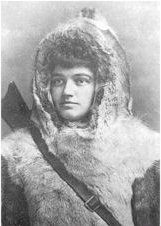(1863-1955), Arctic explorer and writer, was born in Washington D.C. and raised in a wealthy environment as the oldest of four children. After graduating from high school, she attended a business college and worked as a clerk at the Smithsonian Institution where her father taught languages.
At a dancing class, she met Robert E. Peary, a Naval Civil Engineer, from Portland, Maine. During their courtship, Robert was off on projects in Nicaragua and Greenland. They married in 1888 and began what would be a long and often strained relationship that would withstand many years and unbelievable hardships. They lived in Washington but later moved to New York and Philadelphia.
While in Greenland, Robert developed a plan to explore the northern tip of Greenland. Josephine helped him raise the money using her father’s contacts. Sponsors included the American Geographical Society. In 1891 the Pearys set off on their expedition. Josephine was the first woman ever to take part in an Arctic expedition.
Her role was as a nurse, cook, and a hunter. Among crew members was Matthew Henson, an African American who at the time served as Peary’s valet.
At first Josephine found the Inuits as uncouth but when she realized that the expedition’s success depended on adapting to their way of life, she reached out to the women. They taught her their language and how to make Arctic clothing out of furs.
She kept a journal of her experiences, later published as My Arctic Journal. The entry for September 29, 1891, describes one adventure. She went out to lay some fox traps and hunt deer. As she hiked up the side of a mountain, “halfway up, about a thousand feet above sea level, the snow began to slide under me,. . . and of course I went too, down, down, trying to stop myself by digging my heels into the snow and attempting to grasp the stones as they went by.” This entry was made on her first of seven expeditions with her husband. The other entries document her work ethic and skill at living and working in the harsh environment.
In 1893, even though she was pregnant, the couple once again set out to explore Greenland with hopes of finding a route to the North Pole. The child, born in September less than thirteen degrees from the North Pole, was the first white child born in the Arctic North. They named her Marie Ahnighito Peary, but her nickname was “snow baby” because the Inuits had never seen a white baby before. Her middle name honored the Eskimo woman who made Marie’s first fur suit.
Josephine and Marie sailed home the following summer leaving Robert behind for two more years. They sailed for Greenland in 1897 and on their return, Josephine wrote The Snow Baby, a popular children’s book, with photographs and details about life and nature in the Arctic.
In 1900 she organized an expedition back to Greenland after she got the news that her husband’s toes had to be amputated, but the boat they were on, the Windward, hit an iceberg and they were frozen in for the winter 300 miles south of Robert’s camp. When they finally joined up, Josephine met Robert’s Inuit woman partner, Allakasingwah. Despite the feelings it must have aroused in her, Josephine remained supportive of Robert’s goal to discover the North Pole.
With the birth of the Peary’s second child, Robert, Jr., in 1903, Josephine stopped traveling North. She continued to lecture and write to raise money for Robert’s goal to discover the North Pole. His success in September 1909 reached her while she was living in their summer home on Eagle Island, in Harpswell in Casco Bay.
By then an Admiral, Robert turned to other interests, but the couple had to devote much time to defending his discovery. After he died in 1920, Josephine continued to live in Portland in the winter and on Eagle Island in the summer until her death in 1955. A few months before her death, the National Geographic Society awarded her its highest honor, the Medal of Achievement. She was buried next to her husband in the Arlington National Cemetery. Their children donated Eagle Island to the State of Maine where it is operated for visitors as a state park during the summer months.
Photo, courtesy of Maine Women Writers Collection, University of New England, Portland, Maine.
Additional resources
Kennedy, Kate. “Josephine Diebitsch Peary” in More than Petticoats: Remarkable Maine Women. Guilford, CT: Globe Pequot Press, 2005, pp. 73-83.
Maine Women Writers Collection, University of New England. Josephine Peary’s Papers with an introduction by Corina Tanguary available on: http://www.une.edu/mwwc/ams308/peary.htm (accessed June 2, 2008).
Peary, Josephine Diebitsch. Children of the Arctic, by the Snow baby and her mother. New York. F.A. Stokes Co. 1903.
Peary, Josephine Diebitsch. My Arctic Journal: A Year Among Ice-Fields and Eskimos. New York: Contemporary Publishing Co., 1893.
Peary, Josephine Diebitsch. The Snow Baby. New York: Frederick A. Stokes, 1901.
Peary-Macmillan Arctic Museum. Bowdoin College. Brunswick Maine [exhibits,photographs, film, and manuscripts]
Contributed by Paul Hanley, Phippsburg, Maine, 2008.


